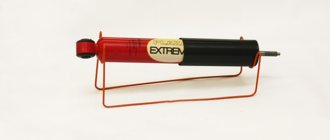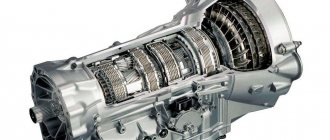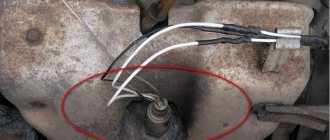History [edit | edit code]
On August 16, 1967, a general agreement was signed in Moscow between the Italian company Fiat and the Soviet Foreign Trade on scientific and technical cooperation in the development of passenger cars. Within its framework, a project for the construction of an automobile plant on the territory of the USSR was approved. This agreement also determined the models themselves: two cars in the “norm” configuration with sedan (VAZ-2101) and station wagon (VAZ-2102) bodies, and a luxury car (VAZ-2103). The Fiat 124 was immediately identified as the prototype for the “norm”, which received the title “Car of the Year” in 1967.
In the summer of 1966, the first acquaintance of Soviet specialists with the Italian car took place. During tests on Soviet roads, the cars revealed serious problems with the durability of the body and rear disc brakes. The low ground clearance and lack of towing lugs made operating the vehicles on the country roads problematic. The dissatisfaction of Soviet engineers was also caused by the lower engine - absolutely unpromising from the point of view of further development of the design. All comments of Soviet specialists were taken into account by Italian designers [1].
The chassis and transmission have undergone no less serious changes. As a result, the VAZ-2101 began to differ from the Fiat 124 in brakes (drum mechanisms appeared at the rear, which can easily withstand bad roads), suspension (the front was strengthened, the rear was completely replaced with a more modern one with five reaction rods instead of a reaction pipe), cardan transmission (an open shaft with an intermediate support), reinforced clutch and modified design of synchronizers in the gearbox [1].
The first six VAZ-2101 cars were assembled on April 19, 1970, and the rhythmic work of the main conveyor began in August. Soon the production of the VAZ-2102 station wagon began. From 1972 to 1984, the “luxury” model VAZ-2103 was produced. In 1976, production of the improved VAZ-2106 model began [2]. The eighties were marked by the launch of production of models with a rectangular front design - VAZ-2105, VAZ-2104 and VAZ-2107 [1] [3].
On December 30, 2010, production of the VAZ-2105 ended due to low demand from the entire classic VAZ family and almost complete unification with the VAZ-2107. On April 17, 2012, the IzhAvto plant stopped producing the VAZ-2107. The latest model of the Lada VAZ-2104 was discontinued on September 17, 2012.
Pros and cons of the twelfth model
Communities Lada Priora Lada Priora Club Blog Alternator belt length EURAir conditioner
The duality of the design concept led to the fact that the Lada 12 was never the only five-door hatchback in the production program of the Tolyatti plant. The AvtoVAZ hatchback VAZ 2112 rolled off the assembly line from 1999 to 2008. It shared its place on the assembly line with other five-door cars in the same body:
- from 1999 to 2001, Lada 12 and VAZ 2109 were produced in parallel;
- from 2001 to 2004, VAZ 2112, VAZ 2109 and VAZ 2114 were released simultaneously;
- from 2004 to 2008, model 12 was produced in parallel with the VAZ 2114.
The features of the target audience of the 12th fret are very poorly read, in contrast to alternative models. Buyers of the VAZ 2109 represented a large army of staunch supporters of the most popular domestic car of the 90s - the “nine”, glorified in songs. The fourteenth model that appeared later also had many fans. A light face lift only benefited the car. New headlights and the design of the front end refreshed the appearance of the car; it became noticeably more modern, which the market liked.
The Lada 12 had little to offer in this competitive competition. The electronic fuel injection engine control system offered few advantages because the first twelfth models entered the market with a carburetor version of the engine. When injection versions of the Lada 12 appeared, competitors were not slow to repeat this move. All that remained was a more than dubious attempt to follow the ideas of biodesign that was fashionable at that time. Such tuning of the VAZ 112 did not give serious success, because:
- the ideas themselves were 15 years out of date by the time the car appeared;
- they were implemented very clumsily.
In terms of technical parameters, models 2112 and 2114 are very similar. VAZ 2112 is 4 centimeters longer than its brother in the production line. For comparing cars of the same layout, the volume of a cube is great, into which you can fit a car with specific dimensions. This parameter is in the case of model 2114 4122 mm x 1650 mm x 1402 mm = 3817 cubic meters. dm. And for 2112 - 4170 mm x 1680 mm x 1435 mm = 4050 cubic meters. dm. The difference is 5.7%. In terms of total weight, the cars (1410 and 1495 kg, respectively) differ by 5.6%.
But the trunk of the VAZ 2114 is significantly smaller - 330 liters versus 399. Additionally, in Lada 12 you can free up another 330 liters for luggage by folding the rear seats. You can fold them partially - the back is divided in a ratio of 1:2, and the parts fold independently of each other. Car owners note that the interior of the twelfth model is cramped for passengers taller than 180 cm. Common to both cars, car enthusiasts note shortcomings in the operation of the heating system, shortcomings in seat adjustments, as well as a creaky interior.
Title [edit | edit code]
Since in a number of European countries consumers associated the word “Zhiguli” with the dubious concept of a gigolo, the “Zhiguli” trademark was soon replaced by “LADA” on the foreign market. Models were named by engine size, for example, Lada 1300.
The modernized models of the VAZ-2104, VAZ-2105, VAZ-2107 subfamily were also sold on the domestic market under the Zhiguli brand, and on the foreign market - only under the LADA brand (while export models, in addition to being designated by engine displacement, were sold on in some markets under the names Lada Saloon, Lada Nova, Lada Riva, Lada Estate and even Lada Kalinka) [6].
In the 1990s, AvtoVAZ abandoned the use of the word “Zhiguli”, using index designations in the domestic market (at that time they produced VAZ-2104, VAZ-2105, VAZ-2106 and VAZ-2107), but this word was firmly entrenched in the public consciousness. In everyday life, such cars are often called “Zhigul” and “Zhiga”, and specific models are called by number (“seven”, “five”, etc.). In the automotive press they began to be called "classic models" or simply "classics" [ source not specified 313 days
] . In particular, the unrealized Zhiguli modernization project, for which the VAZ-2107M prototype was released in 2009, was codenamed Lada Classic-2.
What does Lada Vesta look like? Interesting facts about the car, price, personal experience, pros and cons.
What does Lada Vesta look like?
The official Lada Granta Club informed that last weekend AVTOVAZ in Sochi made the first official test drive of the LADA Granta for journalists. The online publication “Behind the Wheel” was the first to present the results of the test drive. Dmitry Konin and Timur Khasanov traveled to Sochi from this publication.
The Grant was tested on the track and on serpentine roads.
Khasanov, besides this, Fr.
At the end of the Sochi track, journalists went to test the LADA Granta along the Lazorevskoye route. Along the way, they were able to evaluate the consumer features of the car in more detail. According to Khasanov’s point of view, the front seats are quite ergonomic.
Khasanov says that the tachometer and speedometer readings are easy to read. You have to peer into the monochrome symbols of the on-board computer numbers. You can find these details about what the Lada Vesta looks like on our website Lada-Vesta.Jacrein-Club.ru in the near future. On a cobblestone road, the torpedo and the monolithic door trim of the LADA Granta are silent. This is a good bonus to reduce the price of the car. Among the disadvantages of the interior, the journalist noted the inconvenient placement of the window lift button on the front passenger door (it is located exactly right under the elbow) and the absence of an upper handle. If you are thirsty, you can, of course, install the handle yourself; for this purpose, there is a stamping on the lid trim in the regular place of the handle.
The rear seats, according to Khasanov’s point of view, are quite spacious. Along with this, headrests would not be out of place. The amount of luggage space increases when the sofa and one-piece backrest are folded. The trunk space is impressive. Khasanov O.
The Granta motor performed well in the mountains. It was tuned so that it perfectly pulls a car with three passengers uphill, even at low speeds. Moreover, the engine potential is enough to overtake on narrow high-altitude highways. The brakes, according to the journalist’s point of view, are not enough ABS, which is installed on all standard equipment of European cars.
Models [edit | edit code]
A total of 7 Zhiguli models were produced with indexes from 2101 to 2107. The index of each model could contain a fifth digit indicating the modification of the car: for example, the Egyptian “seven” had an index of 21074. Detailed information about the features of each model is given in the relevant articles .
Production models[edit | edit code]
- VAZ-2101 (1970-1988) is the very first model that received the popular name “kopek”.
- VAZ-2102 (1971-1986) - version of the 2101 model with a station wagon body.
- VAZ-2103 (1972-1984) - a model with improved equipment, distinguished by dual headlights and an abundance of chrome in the trim, at the time of its debut it became the flagship of the model range.
- VAZ-2104 (1984-2012) - a station wagon based on the 2105, the latest model in the range, known in export markets as Kalinka and Signet.
- VAZ-2105 (1979-2010) - the first model with rectangular headlights and a new interior design, known in export markets as Riva, Nova, Laika and Clasico.
- VAZ-2106 (1976-2006) - an improved version of the 2103 model, with fewer chrome parts in the trim, at the time of its debut it became the flagship of the model range.
- VAZ-2107 (1982-2014) - the luxury version of the “five”, known in export markets as Riva, Nova and Signet, at the time of its debut it became the flagship of the model range.
Prototypes and concepts [edit | edit code]
- VAZ-2107M, the so-called Lada > Years of production [ edit | edit code]
Production and sales [edit | edit code]
In 2003, about 265 thousand classic Zhiguli cars were produced. In 2006, the VAZ-2106 “six” was discontinued from production (assembled from large-unit kits at IzhAvto), having lasted on the assembly line for 30 years. In 2007, production of the LADA 21053 and LADA 21070/21074 models continued at VAZ, SKD assembly of the VAZ-21043 model at (IzhAvto); VAZ-21070 models since 2002 in Ukraine (LuAZ, ZAZ and KrAsZ) and since 2006 in Egypt. In 2007, about 234 thousand cars of this family were produced (18% of passenger car production in Russia), thus Zhiguli remained the most popular in production (despite some decline) and especially in consumption in Russia. The longest produced car of the family was model 2105 (31 years from 1979 to 2010).
"Zhiguli" or "Lada"?
The less time remains before the round date, the more events related to “Behind the Wheel” are asked to appear on the anniversary pages. Having immersed ourselves in the magazine’s files, we refreshed our memory about something that may be of interest to readers today. However, you can judge this for yourself.
In the “We were the first” section, we will not talk about publications that revealed something completely new to the person behind the wheel in the world of engines (ZR always saw his purpose in this), but about the public actions of the magazine that left a mark on the automotive history of the country.
The event in question occurred on the eve of the first wave of Russian motorization - the launch of VAZ. It was then, in November 1968, at a time of great expectations and hopes (remember the first motto of ZR - “A car for the working people!”) the magazine announced a competition for the best name for VAZ models, limiting its period to one month - December. We were ready for the activity of readers - the circulation at that time had already reached 2 million copies, but the gushing flow of responses exceeded all expectations: the editors received 54,838 (!) suggestions. 6,225 of them did not meet the conditions of the competition, but the remaining 48,613 applications included... 1,812 titles.
The jury faced a difficult task. It included the vice-president of the international and chairman of the All-Union Automobile Federation (FAS USSR), rector of MADI L. Afanasyev, head of Autoexport V. Petrov, film director E. Ryazanov and other no less famous people in automotive circles. I was entrusted with representing the magazine on the jury.
Now, almost forty years later, it is interesting to run through the list of almost two thousand proposals. They figuratively reflected their time and the feelings that so many experienced while waiting for VAZ’s first child. The “ideological component” was natural for that time - Lenin’s 100th anniversary was just around the corner and names like “Centenary”, “Lenivat”, TAZ-VIL, “Lenin Star”, “100 Lenin” and the like were not perceived as eccentricities. But there were far more proposals expressing sympathy for Italy in general and its car in particular. The Italian component could probably be of interest even to linguists from the Apennines. There were all sorts of applications here: “Rossital”, “Rusital”, “Antonio Gramsci”, “Garibaldi”, “Rome-8”, “Italyanochka”, “Moscow-Rome” and of course “Togliattinets”, “Tolyatik”, “Tolyatta”, “Tolyaross”, “FIAT-Russia”. Not without, of course, “Cippolino”, “Robertino” and dozens of other names and nicknames familiar to us. But perhaps that's enough.
In terms of the number of votes, which the jury considered first, the top five were “Volzhanka” (3989), “Druzhba” (2878), “Dream” (2806), “Zhiguli” (2220) and “Lada” (1752). A choice had to be made from them. They decided to abandon the simple names associated with the location of the plant: there were already “Volga” and “Moskvich”. We settled on the original Russian Lada - beloved, desired. It sounds beautiful, easy to read and pronounce not only in Russian. But the decision of our jury is just a recommendation - the name of the first-born was given by the ministry and the plant. They were in no hurry. The release date of the first batch of cars was already approaching, but there was no name. There were only rumors. “Behind the Wheel” responded to the puffs with a letter from its reader from Leningrad. He read in the local newspaper that the VAZ car would be called “Zhiguli”.
“It’s very disappointing,” he wrote, “when common sense is trampled underfoot in the pursuit of geography. You can imagine what will happen if the Zhiguli cars are released: our plant purchased five Zhiguli cars. Or I'm going to buy a Zhiguli. Language incidents and inconveniences will begin. Finally, people will write and talk about the new car abroad, but neither English nor German has the letter “Zh” as such - all sorts of “Shiguli” and “Shchekuli” will go for walks around the world. Naming a car well is, if you like, half the battle.”
The fears of the author and the magazine were not in vain. At the beginning of 1970, Zhiguli cars rolled off the assembly line of the plant. They say that the Kuibyshev regional party committee really insisted on this. Our great and mighty somehow coped with the linguistic “overlays,” but only in the internal space. Already in the fall of 1970, the board of Autoexport decided to “consider it impossible to supply for export a VAZ car (at that time these were large quantities unprecedented for the country) with the name “Zhiguli” - its pronunciation in other languages is difficult and dissonant.” “SLAVA” (Soviet passenger car of the Volzhsky Automobile Plant) was proposed, which also did not receive support. Our “Lada” triumphed, which later became the name of the entire family of VAZ cars.











